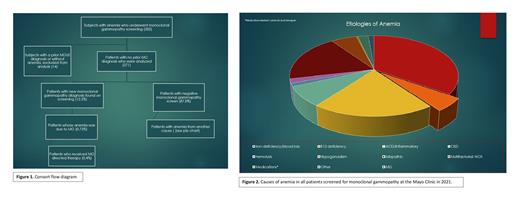Background
Screening for monoclonal gammopathy (MG) is often performed in the evaluation of anemia. While certain MGs may be associated with anemia, these are rare conditions. Monoclonal gammopathy of undetermined significance (MGUS; prevalence of 8% among age >50 years) is common, but rarely causes anemia in isolation. Therefore, abnormal results from MG screening may be unrelated to patient symptoms and result in both financial and psychological harm. Limited data exist to guide clinicians regarding the utility of MG testing for anemia.
Aims
This study aims to describe both the clinical utility of MG screening during the evaluation of anemia and the most common etiologies for anemia in patients whose workup included MG screening.
Methods
We reviewed medical records of patients who received MG screening to evaluate anemia at Mayo Clinic in 2021. Patients with a previously diagnosed MG were excluded. MG testing included serum protein electrophoresis and free light chain assessments. The following data were extracted: hemoglobin, hematocrit, mean corpuscular volume (MCV), calcium, creatinine, eGFR, and the final hematologic diagnosis related to the monoclonal protein. Clinician documentation was evaluated to determine the attributed etiology of anemia.
Results
Among the 271 patients with anemia who were screened for MG, 33 (12.2%) were found to have a newly diagnosed MG. Only 2 patients screened for MG were ultimately found to have anemia caused by MG. These included a case of multiple myeloma and one patient with cold agglutinin disease and secondary hemolysis. In all patients screened, their anemia was ultimately thought to be due to iron deficiency (31.7%), B12 deficiency (3.0%), anemia of chronic disease (ACD)/inflammatory anemia (14.4%), chronic kidney disease (CKD) (3.7%), hemolysis (1.5%), hypogonadism (1.9%), idiopathic (21.0%), multifactorial: iron deficiency + ACD/inflammatory (3.0%), multifactorial: nutritional; iron deficiency + B12 deficiency (3.0%), multifactorial: ACD + CKD (5.2%), multifactorial: iron deficiency + CKD (1.8%), multifactorial: not otherwise specified (NOS) (6.6%), medications (0.4%), and other (2.6%). Both patients with newly diagnosed MG associated anemia presented with peripheral neuropathy as their primary symptom. Among these 2 patients diagnosed with dysproteinemia associated anemia, only one (0.4%) was placed on therapy for their MG.
Summary/Conclusions
In the evaluation of anemia, routine MG screening has low clinical utility. Less than 1 in 100 patients were found to have anemia attributable to MG. Furthermore, only 0.4 in 100 patients received MG-directed therapy. Most patients screened with SPEP for undifferentiated anemia were found to have anemia attributable to common causes including iron/nutritional deficiency, inflammatory processes, and CKD. Most patients with undifferentiated anemia would benefit from an anemia evaluation that focuses on the most common causes up front. Given the cost to healthcare and potential psychological harm to the patient of incidental MG diagnosis, further study is warranted to guide clinicians and limit the ordering of MG testing to individuals who are most likely to derive benefit.
Disclosures
No relevant conflicts of interest to declare.


This feature is available to Subscribers Only
Sign In or Create an Account Close Modal